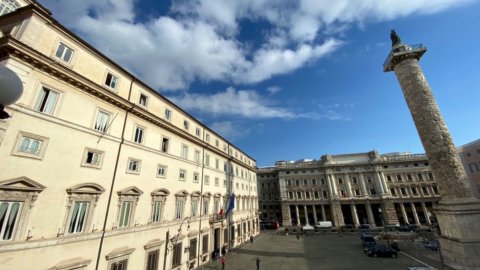Orders and exports are confirming the attenuation of the recession in Italian industry: production has stopped falling, even if it remains very low and far from pre-crisis levels; on the other hand, the activity of services and construction is still declining. The OECD anticipator indicates a turnaround in the country's economy by next autumn at the latest. The change of course is favored by the more dynamic international context, thanks to the confirmation of recovery in the USA, the recovery of Japan and the robust contribution to the increase in world demand by emerging countries, despite the slowdown of the BRICs. The slightly lower cost of energy, the easing of the restriction of budgetary policy (thanks to the structural equilibrium achieved) and the less pessimism of households help.
However, consumer spending will be penalized by the need to rebuild savings, by the difficulty in obtaining credit and by the decline in employment, which will continue for many months to come. Another fundamental obstacle to the recovery is the restriction of business loans, both in terms of volumes (also falling sharply in May) and in rates; this stranglehold can be eased by the ECB's recent measures and by the rapid execution and expansion of payments of general government arrears.
Monetary policy in the Eurozone will remain expansive for a long time, but does not operate effectively in all countries due to the unresolved European crisis in dealing with the vicious circle between public debts and bank balance sheets, the latter now weighed down by the effects of the recession; fact that tends to prolong the credit crunch.
The indicators in the Euro area improve, but the political tensions in many countries keep uncertainty high and differentials on sovereign bonds wide, which are reflected in the structure of the cost of money in each economy. The German elections are approaching on the horizon, with results that cannot be taken for granted and on which a large part of the next vital decisions for the exit from the serious current difficulties depend.
In Italy, the increase in production in June (+0,4% on May, CSC estimates) brought the contraction in the 1,0nd quarter to -2% (+0,3% transmitted to the 3rd); trend consistent with a further decrease in GDP, after -0,6% in the 1st over 4th 2012. The OECD anticipator recovers from November (+0,27% in May) and signals the end of the recession and the start of a recovery phase as early as 2013.
In June, assessments on orders improved (-39 from -43), especially foreign ones (-20 from -28), and the production component of the manufacturing PMI returned to expansion for the first time since September 2011 (50,3 from 46,8 ,XNUMX).
Uncertain consumption: -0,2% the ICC volume indicator in May and +2,7% monthly for car sales in June. The balance of business assessments on investment conditions rose to -32,0 in June from -47,3 in March; that relating to forecasts on general economic conditions is -19,7 from -44,8 (Bank of Italy – Il Sole 24 Ore).
During the recession that began in the 3rd quarter of 2011, household spending fell more than real disposable income (-6,6% against -5,7%). Thus the savings rate, after the historic lows reached in the 2nd quarter of 2012 (7,7%), rose again to 9,3% in the 1st of 2013. But it is still far from the pre-crisis average (13,2% between 1999 and 2007).
Strengthening household confidence can support consumption. However, the progressive improvement in assessments on the household budget (balance to -16 in July, from -23,0 in the 2nd quarter of 2013 and -28,0 in the previous one) was accompanied by an increase in assessments on future savings opportunities ( balance at -51, from -72,0 in the 2nd quarter and -88,0 in the first 2013). This seems to suggest a greater desire for thrift, which would curb spending.
The reduction in loans to Italian companies continues: -0,8% in May (-6,2% since September 2011, equal to -57 billion euro; seasonally adjusted data). The interest rate remains too high (3,5% in May), with a spread on the Euribor of 3,3 points (0,6 in 2007).
Many Italian companies, even in good financial condition, are denied credit: in June 16,3% of those who applied for it did not obtain it (6,9% in the first half of 2011; ISTAT). Liquidity is scarce: 25,6% of companies expect insufficient resources in the 3rd quarter (Banca d'Italia-Il Sole 24 Ore survey).
The expectation of a slowdown in purchases of FED securities drives up US long rates: 3,6% in July for 30-year Treasury bonds (2,9% in April), 2,6% for 1,8-year bonds (1,8% ). This risks infecting European rates: 10% in June for the 1,2-year Bund (1,6% in April), then 50% in July. To support credit, the ECB has expanded the list of securitized loans acceptable as collateral. Fears of inflation and capital outflows instead led to rate hikes in Brazil (+8,5bps to 50%), Indonesia (+6,5bps to 75%), Turkey (+7,25bps overnight to XNUMX%) and stopped the cuts in India.
New record for unemployment in Italy: in May there were 3 million 140 thousand people looking for work, 12,2% of the workforce (+0,2 points over April). The employed decreased again: -27 thousand on the previous month (-0,1%), -387 thousand on the previous year (-1,7%). The decline will continue: companies' expectations on employment in the current quarter are still negative, at the levels of the end of 2009 (Bank of Italy-Il Sole 24 Ore survey).
The CSC estimates that the equivalent work units in CIG amounted to 330 thousand in June (+1,1% on the previous quarter). In the coming months, recourse to the CIG will remain high. However, in the face of low levels of activity, there will also be further job cuts.
Weak labor market in the Eurozone: in May the unemployment rate reached 12,2%, an all-time high. It rose in France (10,9%, +0,1 points over April), fell in Germany (5,3%, -0,1 points).
The picture of construction in Italy remains very fragile. The expectations of construction companies indicate that the slump in activity (-15,0% added value from 1st quarter 2008 to 1st 2013) will continue in the near future: assessments on orders remain very negative, in June on the levels of mid-2009 Residential and non-residential investments will continue to be held back, respectively, by the persistence of the real estate market crisis and by the high unused production capacity.
The Italian housing market is still worsening, as indicated by the collapse of recorded sales (-14,2% trend in the 1st quarter of 2013), the increase in the share of real estate agencies reporting negative changes in prices (83,1% in the 2nd quarter) and the discount on the initial request (15,6%). Due to its effects on household wealth and confidence, the weakness of the real estate market will also help to curb consumption.
Construction will also act as a ballast in France, the Netherlands and Spain, while it will act as a boost in Germany and the USA.
The price of Brent translated into euros is 82,7 euros per barrel in July, from 87,3 in February (peak at 94,4 in March 2012). According to CSC forecasts, the price of oil will drop to 78 euros on average in 2014, from 87 in 2012 (equal to -10,3%). A drop, albeit at still high levels, justified by the overtaking of production on world demand and by the recovery of OPEC unused capacity.
The decline in oil is rapidly transmitted to the consumer price of energy in Italy: -4,1% in June from the peak in September 2012. As an annual change, energy prices recorded a -0,5% in June, from +15,9, 1,2% in September. This led to a reduction in the dynamics of the general index (+3,2%, from +XNUMX%).
Lower energy prices support consumption, because they free up resources for the purchase of other goods and services. The energy item absorbs 9,5% of household spending, up from 7,9% in 2011 due to the increase in prices and despite the collapse in volumes (fuels -4,3% in the first half of 2013, -16,3% in 2008-2012). The cheapest energy also supports current operations and investments by reducing the costs of businesses.
In Europe, the budgetary restriction is easing this year and next year there will be a return to slightly expansive policies, after four years of austerity. In the Eurozone, the cumulative change in structural balances exceeds 3% of GDP and will be 0,8% of GDP this year, after 1,4% in 2012 and 0,9% in 2011.
Greece has just approved yet another maneuver which will entail a cut of 25 civil servants. In Portugal, the political crisis bears witness to the reduction of consensus on the program negotiated with the European troika. Italy was downgraded by Standard & Poor's due to poor growth prospects.
An important signal comes from the European summit at the end of June in which it was decided to allocate: 8 billion, to be disbursed in 2014 and 2015, to combat youth unemployment; 10 billion as financial leverage to increase loans to small and medium-sized enterprises. It is a first step but resources are insufficient.
In May, Italian exports increased by 0,5% in volume over April, thanks to the increase in sales to non-EU countries (+3,1%) which more than offset the reduction in those within the EU ( -1,8%). The growth in the export of capital goods (+3,5%) and the rebound in that of energy products (+15,2%) contributed, after the fall in the first quarter of 1 (-2013% on the last 17,8).
The prospects for improvement are consolidating: the PMI on foreign orders, in an expansive area since the beginning of 2013, reached its highest level since April 2011 in June (52,2); in the 3rd quarter the dynamics of foreign demand will be favourable, according to exporting companies, especially of larger dimensions (Bank of Italy-Il Sole 24Ore).
However, the slowdown in emerging economies is holding back world trade. Indeed, the PMI on global foreign orders is worsening, falling below the neutral threshold of 50 (to 48,5) in June; in particular, those in Germany (47,0) and France (46,7) were down.
The recovery of confidence in the Euro area continues. The composite indicator improved by 1,8 points in June, to 91,3 (+0,9 points in May). Among consumers, the balance increased by 3,1 points on May (+7,9 from November 2012; in flash estimates it rose by 1,4 points in July); in manufacturing by 1,8 (+6,6 from last October ).
The Euroarea composite PMI recorded another progress in July (50,4 from 48,7, an 18-month high) and signals a modest increase in activity. In particular, the manufacturing PMI exceeds the neutral threshold of 50 (50,1 from 48,8, a 2-year high); production increases (52,3), orders remain slightly down; indicates expansion in Germany (50,3 from 48,6), stability in France (49,8 from 48,4).
The PMI for services in the Euro area goes back to its highest level since January 2012 and reflects a marginal decline (49,6 from 48,3). Growth in the tertiary sector accelerates in Germany (52,5 from 50,4), slows down the contraction in France (48,3 from 47,2).





